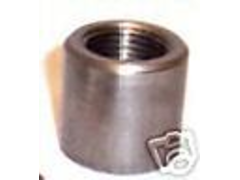
Threaded Suspension Inserts, Tapered or Not?
liam.mccaffrey - 19/8/13 at 11:19 AM
I'd always wondered why there were tapered inserts for threading in rod ends/rose joints/spherical bearings/heim joints
Then someone told me that it was to reduce the bending moment on the rod end threaded shank?!?!? I can't for a minute think that the bending
moment would be much different between the the two types of insert.
Other than aesthetics is there another reason why tapered inserts are used? Anyone know?
Unless you don't follow what I mean, its the threaded inserts welded into suspension link tube.
Tapered Insert


Tapered Insert
Non Tapered Insert


Non Tapered
[Edited on 19/8/13 by liam.mccaffrey]
Mr Whippy - 19/8/13 at 11:38 AM
Aren't they meant to be in compression or tension? Where's the bending moment coming from?
mark chandler - 19/8/13 at 11:39 AM
Just looks like more leverage on the welded joint to me, the weak points going to be where the nut sits on the rose joint.
Standard insert works for me, they just look pretty IMHO
liam.mccaffrey - 19/8/13 at 11:40 AM
You're right, there shouldn't be!
For what its worth I've always used non tapered.
[Edited on 19/8/13 by liam.mccaffrey]
Mr Whippy - 19/8/13 at 11:46 AM
The only thing I can think of is that the taper lets you thread it up closer to the rose joint without fouling the suspension however that does depend
on the specific application. As I said though there should be no bending on the thread if the load is transferred correctly. There use to be some
wishbones that were U shaped and the rose joints did not point directly at the hub but that is just bad design.
[Edited on 19/8/13 by Mr Whippy]
v8kid - 19/8/13 at 01:37 PM
There will be a fore/aft bending moment.
The taper will not reduce the bending moment but it will make the resultant stress distribution more even.
Sudden changes in section cause stress concentration and cracks to grow.
Having said that I doubt it would make much difference, the cut screw thread is a muc more likely stress riser.
luke2152 - 19/8/13 at 06:42 PM
Wouldn't the tapered bit allow it to rotate through a greater angle before the non movey bit of the joint comes into contact
britishtrident - 19/8/13 at 08:24 PM
Tapered ones tend to be use with larger dia tubes.
Camber Dave - 19/8/13 at 09:50 PM
The taper gives a progressive change of section between the tube and the flats of the half nut locking the rod end.
This means the spanner doesn’t foul on the insert causing unsightly gouges and compromising torque.
Often on race cars flats are milled on the taper for a spanner. This means the mechanic can keep the rod end correctly aligned with one hand and
squeeze two spanners together to tighten the nut without straining the track rod, pushrod or wishbone.




